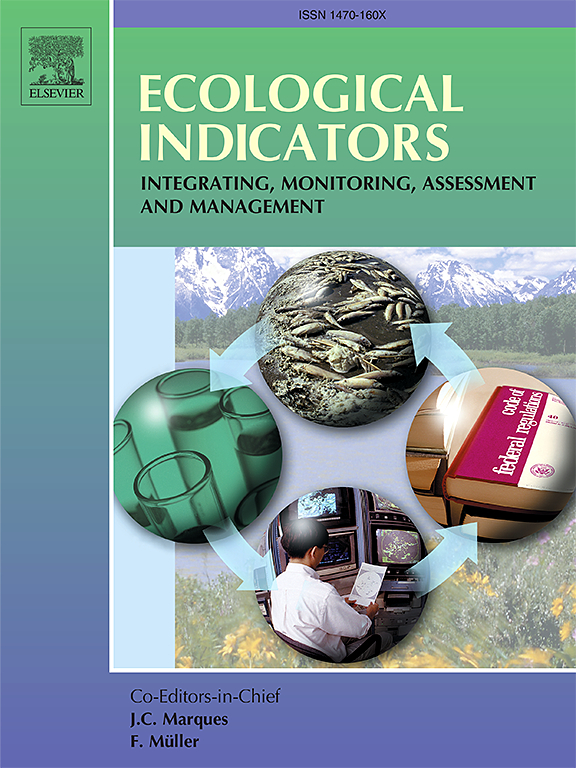基于三维可视化的冠层固碳能力高级智能识别算法:在干旱胁迫下落叶松人工林中的应用
IF 7
2区 环境科学与生态学
Q1 ENVIRONMENTAL SCIENCES
引用次数: 0
摘要
提出了一种先进的基于三维可视化的智能算法来评估和增强干旱胁迫下日本落叶松的碳固存能力。该方法解决了干旱对落叶松林冠结构和光合效率的关键影响,显著降低了落叶松人工林的碳增益。本研究利用高精度三维冠层模型,结合详细的生理数据,揭示了干旱对累积叶面积指数(cLAI)和最大光合效率(Amax)的负面影响。研究结果表明,在干旱胁迫降低总叶面积的同时,优化叶片排列和最小化无效叶面积使树木能够更有效地利用水分进行光合作用,从而保持甚至增强其固碳能力。通过利用3D重建技术,本研究提供了实时、准确的数据,大大提高了我们对极端气候条件下森林生态系统动态的理解。所开发的智能算法为预测和优化森林碳汇提供了一个强大的工具,为森林管理和保护提供了新的机会。先进的三维可视化和智能算法的应用增强了森林管理者和利益相关者的决策过程,促进了科学合理的气候适应战略。这项研究强调了尖端3D建模技术在推进森林保护和管理实践方面的变革潜力。本文章由计算机程序翻译,如有差异,请以英文原文为准。
Advanced intelligent recognition algorithm for tree canopy carbon sequestration capacity based on 3D visualization: application in Larch plantations under drought stress
This study presents an advanced 3D visualization-based intelligent algorithm to assess and enhance Larix kaempferi carbon sequestration under drought stress. This approach addresses the critical impacts of drought on canopy structure and photosynthetic efficiency, significantly reducing carbon gain in larch plantations. Our research utilizes high-precision 3D canopy models combined with detailed physiological data to reveal the negative effects of drought on the cumulative leaf area index (cLAI) and maximum photosynthetic efficiency (Amax). The findings demonstrate that while drought stress reduces overall leaf area, the optimized leaf arrangement and minimized ineffective leaf area enable trees to more efficiently utilize water for photosynthesis, thereby preserving or even enhancing their carbon sequestration capacity. By leveraging 3D reconstruction technology, this study provides real-time, accurate data that significantly improves our understanding of forest ecosystem dynamics under extreme climatic conditions. The intelligent algorithm developed offers a robust tool for predicting and optimizing forest carbon sequestration, presenting new opportunities for forest management and conservation. The application of advanced 3D visualization and intelligent algorithms enhances decision-making processes for forest managers and stakeholders, promoting scientifically sound strategies for climate adaptation. This study underscores the transformative potential of cutting-edge 3D modeling technologies in advancing forest conservation and management practices.
求助全文
通过发布文献求助,成功后即可免费获取论文全文。
去求助
来源期刊

Ecological Indicators
环境科学-环境科学
CiteScore
11.80
自引率
8.70%
发文量
1163
审稿时长
78 days
期刊介绍:
The ultimate aim of Ecological Indicators is to integrate the monitoring and assessment of ecological and environmental indicators with management practices. The journal provides a forum for the discussion of the applied scientific development and review of traditional indicator approaches as well as for theoretical, modelling and quantitative applications such as index development. Research into the following areas will be published.
• All aspects of ecological and environmental indicators and indices.
• New indicators, and new approaches and methods for indicator development, testing and use.
• Development and modelling of indices, e.g. application of indicator suites across multiple scales and resources.
• Analysis and research of resource, system- and scale-specific indicators.
• Methods for integration of social and other valuation metrics for the production of scientifically rigorous and politically-relevant assessments using indicator-based monitoring and assessment programs.
• How research indicators can be transformed into direct application for management purposes.
• Broader assessment objectives and methods, e.g. biodiversity, biological integrity, and sustainability, through the use of indicators.
• Resource-specific indicators such as landscape, agroecosystems, forests, wetlands, etc.
 求助内容:
求助内容: 应助结果提醒方式:
应助结果提醒方式:


